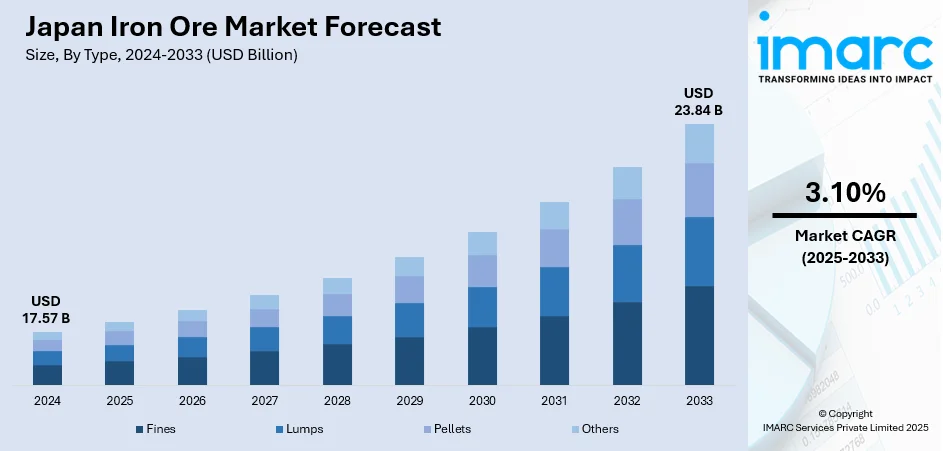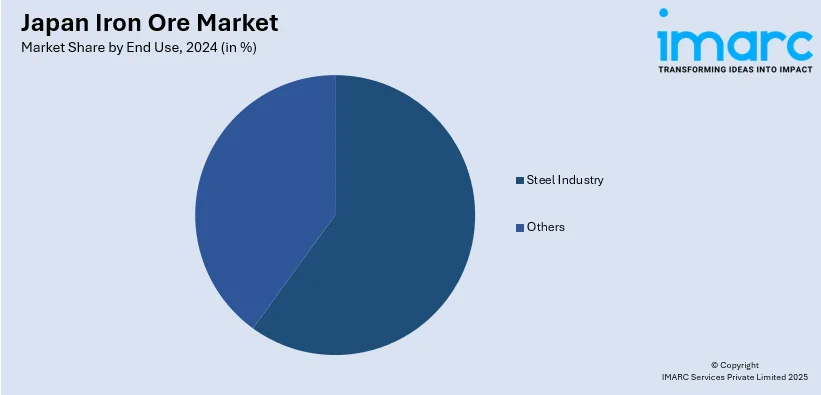
Japan Iron Ore Market Size, Share, Trends and Forecast by Type, End Use, and Region, 2025-2033
Japan Iron Ore Market Overview:
The Japan iron ore market size reached USD 17.57 Billion in 2024. Looking forward, IMARC Group expects the market to reach USD 23.84 Billion by 2033, exhibiting a growth rate (CAGR) of 3.10% during 2025-2033. The market is fueled by the consistent demand for steel production, which majorly depends on iron ore. In addition to this, industrial development in the nation, particularly in the automobile and building industries, enhances the demand for quality raw materials. Further, strategic collaboration between mining firms and the nation's aim to obtain stable supply chains are some of the key drivers expanding the Japan iron ore market share.
|
Report Attribute
|
Key Statistics
|
|---|---|
|
Base Year
|
2024 |
|
Forecast Years
|
2025-2033
|
|
Historical Years
|
2019-2024
|
| Market Size in 2024 | USD 17.57 Billion |
| Market Forecast in 2033 | USD 23.84 Billion |
| Market Growth Rate 2025-2033 | 3.10% |
Japan Iron Ore Market Trends:
Shift Towards Higher-Quality Iron Ore
There is an increasing demand for high-grade ore, especially with iron levels above 62%. This trend stems from the country's increasing emphasis on producing cleaner, more efficient steel to meet environmental standards and enhance product quality. High-grade iron ore has benefits like lower energy consumption as well as lowered emissions during smelting. Japanese steel manufacturers are also under pressure to reduce their carbon emissions, as stipulated by both international and government regulations. Consequently, it has become important for them to source high-quality iron ore from countries like Australia and Brazil, which provide ores with minimal impurities. Apart from this, increasing emphasis on quality rather than quantity is compelling Japanese steel producers to invest in newer technologies, including electric arc furnaces and direct reduction processes, that demand high-grade ores to maximize efficiency. Furthermore, high-grade ore allows for shorter production cycles, enhancing overall cost-effectiveness and competitiveness in the world market.

To get more information on this market, Request Sample
Strategic Supply Chain Management and Diversification
The dependence of the country on imported iron ore has given rise to a trend towards growing attention on supply chain stability and diversification. With domestic mining resources being scarce, Japan imports most of its iron ore, predominantly from Australia, Brazil, and other mining centers. Industry reports indicate that in 2024, Australia provided approximately 55.1% of iron ore imports to Japan. However, supply chain interruptions caused by geopolitical tensions, natural catastrophes, or logistical issues have served to underscore the vulnerability of excessive reliance on a limited number of sources. As a result, Japanese companies are actively seeking alternative suppliers and exploring new regions with untapped iron ore resources. These include long-term purchase agreements, joint ventures with international mining firms, and investments in regional mining ventures. Besides, Japan is utilizing its technological expertise to make mining and transport more efficient. Firms are also exploring opportunities for securing access to ore deposits in untapped areas like Africa and the Arctic. This diversification strategy not only mitigates risks but contributes to the Japan iron ore market growth.
Advancement in Hydrogen-Based Direct Reduction Technologies
A key trend in the market is the growing focus on hydrogen-based direct reduction (HDR) technologies. On May 21, 2025, researchers published a study examining the hydrogen-based direct reduction behavior of iron ore pellets with varying iron contents (59.49% to 67.27%). The study found that higher iron grades and elevated reduction temperatures significantly enhance both the reduction rate and the formation of metallic iron grains. These results are favorable for the creation of more effective, low-carbon steel production processes with the application of hydrogen as a reducing agent. This is in accordance with Japan's movement toward low-carbon steel production since HDR processes utilize hydrogen as a substitute for carbon to reduce iron ore, which considerably reduces CO2 emissions. Additionally, high-grade iron ore with increasing iron content is in rising demand, as it facilitates the effectiveness of such green steel production processes. Japan's steel sector is adopting this technology to meet decarbonization targets, and hydrogen reduction has become a key focus area for future iron ore procurement and steelmaking innovation.
Japan Iron Ore Market Segmentation:
IMARC Group provides an analysis of the key trends in each segment of the market, along with forecasts at the country and regional levels for 2025-2033. Our report has categorized the market based on type and end use.
Type Insights:
- Fines
- Lumps
- Pellets
- Others
The report has provided a detailed breakup and analysis of the market based on the type. This includes fines, lumps, pellets, and others.
End Use Insights:

- Steel Industry
- Others
A detailed breakup and analysis of the market based on the end use have also been provided in the report. This includes steel industry and others.
Regional Insights:
- Kanto Region
- Kansai/Kinki Region
- Central/ Chubu Region
- Kyushu-Okinawa Region
- Tohoku Region
- Chugoku Region
- Hokkaido Region
- Shikoku Region
The report has also provided a comprehensive analysis of all the major regional markets, which include Kanto Region, Kansai/Kinki Region, Central/ Chubu Region, Kyushu-Okinawa Region, Tohoku Region, Chugoku Region, Hokkaido Region, and Shikoku Region.
Competitive Landscape:
The market research report has also provided a comprehensive analysis of the competitive landscape. Competitive analysis such as market structure, key player positioning, top winning strategies, competitive dashboard, and company evaluation quadrant has been covered in the report. Also, detailed profiles of all major companies have been provided.
Japan Iron Ore Market News:
- On January 14, 2025, Japanese firms Nippon Steel and Sojitz acquired a combined 49% stake in its Kami iron ore project in Newfoundland and Labrador, Canada, with investment of USD 245 Million. This deal supports the project's development, which aims to reduce emissions through coal-free steel production, aligning with decarbonization goals. While the Kami Project is still in its feasibility study phase, an estimated USD 4 Billion is required to proceed with development, necessitating strong partnerships.
- On February 23, 2025, Mitsui & Co. announced a USD 5.34 Billion agreement to acquire a 40% stake in Australia's Rhodes Ridge iron ore project, purchasing 25% from VOC Group and 15% from AMB Holdings, while Rio Tinto retains 50% interest. This strategic investment enhances Mitsui's long-term resource portfolio and leverages existing infrastructure from its partnership with Rio Tinto, aligning with the company's efforts to secure stable iron ore supplies for Asian markets.
Japan Iron Ore Market Report Coverage:
| Report Features | Details |
|---|---|
| Base Year of the Analysis | 2024 |
| Historical Period | 2019-2024 |
| Forecast Period | 2025-2033 |
| Units | Billion USD |
| Scope of the Report |
Exploration of Historical Trends and Market Outlook, Industry Catalysts and Challenges, Segment-Wise Historical and Future Market Assessment:
|
| Types Covered | Fines, Lumps, Pellets, Others |
| End Uses Covered | Steel Industry, Others |
| Regions Covered | Kanto Region, Kansai/Kinki Region, Central/ Chubu Region, Kyushu-Okinawa Region, Tohoku Region, Chugoku Region, Hokkaido Region, Shikoku Region |
| Customization Scope | 10% Free Customization |
| Post-Sale Analyst Support | 10-12 Weeks |
| Delivery Format | PDF and Excel through Email (We can also provide the editable version of the report in PPT/Word format on special request) |
Key Questions Answered in This Report:
- How has the Japan iron ore market performed so far and how will it perform in the coming years?
- What is the breakup of the Japan iron ore market on the basis of type?
- What is the breakup of the Japan iron ore market on the basis of end use?
- What is the breakup of the Japan iron ore market on the basis of region?
- What are the various stages in the value chain of the Japan iron ore market?
- What are the key driving factors and challenges in the Japan iron ore market?
- What is the structure of the Japan iron ore market and who are the key players?
- What is the degree of competition in the Japan iron ore market?
Key Benefits for Stakeholders:
- IMARC’s industry report offers a comprehensive quantitative analysis of various market segments, historical and current market trends, market forecasts, and dynamics of the Japan iron ore market from 2019-2033.
- The research report provides the latest information on the market drivers, challenges, and opportunities in the Japan iron ore market.
- Porter's five forces analysis assist stakeholders in assessing the impact of new entrants, competitive rivalry, supplier power, buyer power, and the threat of substitution. It helps stakeholders to analyze the level of competition within the Japan iron ore industry and its attractiveness.
- Competitive landscape allows stakeholders to understand their competitive environment and provides an insight into the current positions of key players in the market.
Need more help?
- Speak to our experienced analysts for insights on the current market scenarios.
- Include additional segments and countries to customize the report as per your requirement.
- Gain an unparalleled competitive advantage in your domain by understanding how to utilize the report and positively impacting your operations and revenue.
- For further assistance, please connect with our analysts.
 Request Customization
Request Customization
 Speak to an Analyst
Speak to an Analyst
 Request Brochure
Request Brochure
 Inquire Before Buying
Inquire Before Buying




.webp)




.webp)












